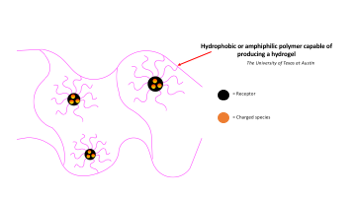Reports: ND756925-ND7: Ligand-Functionalized Block Copolymer Materials for the Demetallization of Crude Oil
Jonathan L. Sessler, PhD, The University of Texas, Austin
Funds from the ACS PRF grant have been used to support in part the educational development and research progress of two graduate students, Rob Fimognari and Matt Moore. It has also provided partial support for a postdoctoral fellow, Xiaofan Ji. The overarching goal for all three project participants has been to join ion receptors with polymeric backbones. To date, good progress has been made by Rob and Xiaofan; however, Matt has largely been "bogged down" in ligand synthesis. This report will thus summarize briefly what has been accomplished by Rob and Xiaofan. It is hoped and expected that the next report (for Year 2) will serve to highlight Matt's work. However, it is important to appreciate that both students receiving partial support under the aegis of this grant have had a chance for professional growth and development. These opportunities have included the chance to work with postdocs, attend seminars, and meet with visiting speakers, and interact with faculty other than the PI. The career of the PI has also been impacted positively in that the PRF funds have allowed us to branch out and try something quite new in a group that has largely been focused on macrocycle design, synthesis, and biological testing.
The research work supported by the PRF and carried out by Rob has involved the creation of ROMP-based polymers that bear ligands selective for copper. The ability to capture copper is particularly important in the context of potential radiopharmaceuticals. The key isotope, 64Cu, is always contaminated with Ni(II) and separating the two divalent cations (i.e., Cu(II) from Ni(II)) in aqueous media is nontrivial; indeed, it is currently an unsolved problem. Rob successfully functionalized a 2,6-pyridine dicarboxylate in a way that it could be used in ROMP. He characterized the resulting polymer and showed it was selective for Cu(II) over Ni(II). The structure of the free polymer, chelated form, and representative competition data are shown in Figure 1. The work itself has been written up and submitted for publication. Support from this grant is acknowledged. However, as yet, no editorial decision has been rendered.
The research work supported by the PRF and carried out by Xiaofan has involved the creation of a new class of self- and hetero-healing hydrogels containing built-in fluorophores. The result of this "stickiness" is system that can be physically manipulated to produce color codes suitable for reading using a readily downloadable 'app'.
The basic design is shown in Figure 2. The actual materials that comprise the constitute gels are shown in Figure 3. We consider this work exciting given how manufacturers and suppliers depend on information to help them deal with the complexity caused by global operations, value chains, and markets. An ability to transform or adjust encoded information, rather than just storing it in a static form, would allow increased benefits to producers and consumers alike. Our gels provide an approach to the creation of fluorescent 3D color codes that permit the encoding of information and its subsequent masking, demasking, erasure, and dedicated conversion to different encoded forms. An added benefit is that the gel arrays may be reprogramed by both chemical and physical means to allow different information to be read out. Finally, due to the nature of the soft materials involved, the codes can be used as wearable materials allowing modulation-amenable information to be read out in a way that is not possible by use of non-dynamic physical attributes, such as finger prints. A first report on this PRF-sponsored hydrogel project has been submitted for publication. However, as yet the fate of the submission is not known.
Conclusion and Future Plans
This PRF-supported foray into the world of receptor-functionalized materials is off to a nice start. Further work will go beyond anions and cations and the use of polar media. This is expected to allow us to address the original project goals of crude oil purification.















